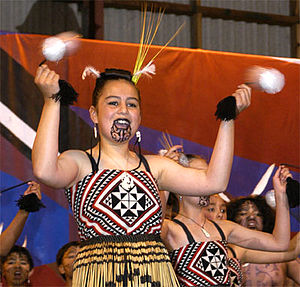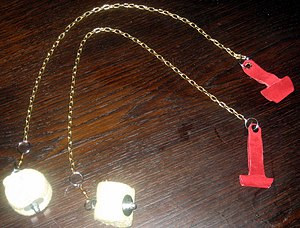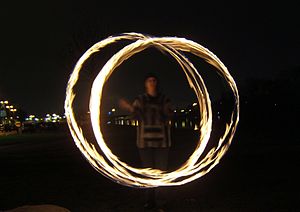AY Honors/Māori Lore/Answer Key
Poi is a form of juggling with balls on ropes, held in the hands and swung in various circular patterns, similar to club-twirling. It was originally practiced by the Māori people of New Zealand (the word poi means "ball" in Māori). Women used it as an exercise to increase flexibility of the wrists and hands, and by men to increase strength in the arms and coordination. It developed into a traditional performance art practiced mostly by women. This art in conjunction with others like waiata a ringa, haka and titi torea form the performance art of Kapa haka.
Modern poi
Today, poi extends far beyond the original māori culture. In juggling circles, a whole subculture has sprung up in some places, surrounding poi spinning as a hobby, exercise, or performance art. Poi are considered a form of juggling, and poi dancers can often be found performing alongside jugglers, staff spinners and other similar performers.
Practice poi
Many people start out using a simple pair of practice poi. These are usually constructed from something soft, in order to lessen the chance of beginners suffering the inevitable minor bruises. Rolled up socks, bean bags or small soft toys on strings are often used. Generally, poi spinners start out with very simple moves, gradually learning to involve more complexity and (eventually) a full performance routine. Many find it helpful to practice spinning their poi to music, in order to keep a good rhythm.
Performance poi
Dancers and performers use brightly coloured poi, home made or bought at juggling shops, or a number of online stores. Fluorescent coloured tails and streamers attached to the poi allow a number of beautiful patterns to be created in the air by the performer, and many spinners pride themselves on the patterns they can make, and the accuracy of their spinning. A number of different forms of poi can be bought, from brightly coloured cones, to cloth blades that can look like dragonfly wings.
A variation on this is with 'Flag poi', consisting of large sheets of lightweight fabric which can be spun round in the same way as regular poi. Often made of reflective or UV-sensitive material, these spin quite slowly and can create the effect that the performer is wrapped in sheets of rippling fabric. The weight and drag created by these flags, however, necessitates the spinner to ensure precision of movement and timing. Consequently, they are difficult for the beginner to grasp.
Glow poi
Glow in the dark poi are available from a number of places, as can glow in the dark gloves, UV sensitive poi and poi containing LED lights that make them shine. Different types of poi can be used to create different effects, depending on the setting. Poi containing small strobes, for instance, can be used to create special effects.
By far the simplest method used is a pair of glow sticks attached to strings. Glow stick poi are popular at festivals and raves, and some brands of glow stick even come with ribbons in the packets, which many find to be ideal.
Fire poi
The "ultimate" performance poi, fire poi (or fire-twirling) are constructed from chain, with kevlar wicks that can be soaked in fuel (usually paraffin, kerosene or a similar household fuel - never petroleum) and set on fire. A fire performance is a breathtaking and exhiliarating feat for an audience and performer alike, provided the poi spinner is competent and confident enough that they can control the fire poi without putting anyone (particularly themselves) at risk.
Many kinds of fire poi are available, the simplest utilising two wicks. The fire wicks are generally one of three varieties: a cylindrical wrap, cathedral stack (square) or a monkey fist knot tied with kevlar rope. Some experienced performers like to pick and choose their wicks, according to the performance they intend to give - controlling their burn time and the brightness of the flames. More advanced fire poi can have multiple wicks.
A variation that some like to use are 'fire snakes', consisting of a length of kevlar rope that can produce a long flame. These can look stunning when used by a skilled performer, resulting in them being surrounded by sheets of brilliant flame.
Poi tricks
As with many subculture sports and pastimes, poi spinners often spend hours mastering their tricks, gaining respect from their peers for managing more impressive stunts.
Some popular poi tricks include: reels, weaves, fountains, crossovers and windmills.
The more skilled the spinner, the more impressive the tricks they can pull. Some more advanced tricks involve body wraps, which involve wrapping a poi string around an arm or leg, then pulling it to swing the poi back in the opposite direction. Split time and split direction moves are possible, and some of the more difficult moves, such as the 'five beat weave', isolation or hyperloop require a considerable amount of manual dexterity, coordination and forearm strength to accomplish.
Poi construction
Many amateur poi spinners like to create their own poi. A simple pair of practice poi require little more than a pair of socks and a couple of tennis balls. More impressive poi can be made from a multitude of different materials. Kite cords are lightweight and readily available. Chain is a more durable alternative to regular cord, ball chains can rotate freely so as to prevent tangling and metal cables can make for extremely fast poi. Long socks can also be used with a weight in one end and a knot in the other. More advanced spinners may add a weight to the handle, in order to improve their ability to perform advanced techniques (such as throws and contact poi).
Kevlar wicks and a variety of poi heads can be bought either from juggling shops, or online, and a number of different kinds of hand grip are available too. This way a performer can customise their poi to suit their own personal preference.
Following are a number of arts from different cultures that bear an affinity to poi.
Club swinging
Using regular juggling clubs, the head of the club can be held in the palm, and the club swung in poi-like patterns. Many poi moves can be attained this way, and as clubs can be stopped at any point of their swing, or swung as slowly as you like, some poi spinners find them useful in learning more difficult poi moves in 'slow motion'.
Sword spinning
Taking influence from the sword displays of the Shaolin monks, some performers learn to do tricks with swords. Swords require a lot more suppleness of the wrists, but can be far faster and more dramatic than poi performances. Practicing with bokken (japanese wooden practice swords) or simple wooden staves is advisable, but when a performer is skilled enough, fire swords can be bought and constructed. Swords, being weapons, should be treated with respect, and not taken too lightly, however.
Nunchaku
The osaka nunchaku, as used by Bruce Lee, employ many similar techniques to poi. While originally a weapon used to fight the Japanese, some companies now produce LED-lit nunchaku which can be used to create unique patterns in performances. Nunchaku are also weapons and should be treated as such.
Meteor
A Meteor is long rope with balls on both ends, usually a monkeyfist knot. It can be used similarly to poi as well as a staff, by keeping very precise timing so that the two balls exert equal force on each other and move in sync. Originally a chinese weapon, meteor are extremely difficult to control. Fire meteors and other variations of this tool also exist.
Safety
Depending on their construction, poi can strike the user (or bystanders) with enough force to cause bruising or minor injury.
Fire poi require a safety regime to deal with the risks of setting on fire either the user, bystanders, or the surroundings.
See also
External links
- Home of Poi Forums, videos, lessons, store.
- Fire Poi World-wide fire poi trainers & performers.
- PlayPoi Poi website featuring videos and photos, both artistic and instructional



